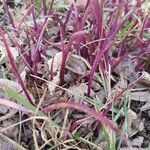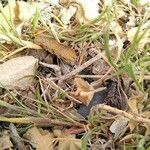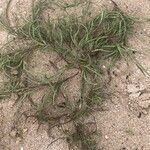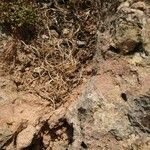Culms tufted, decumbent at base, 10–25 cm tall, much branched in lower part. Leaf sheaths rounded, smooth, glabrous; leaf blades linear, flat or folded, 2.5–8 cm × 1–2 mm, glabrous, abaxial surface smooth, adaxial surface and margins scabrid, finely acute; ligule 0.5–1 mm, truncate. Raceme slenderly cylindrical, 4–10 cm, falcately curved; rachis smooth, joints shorter than spikelets. Spikelets 6–8 mm; glumes as long as spikelet, narrowly oblong-subulate, 3–5-veined, glabrous, acute; lemma lanceolate, 4–5 mm, 3-veined, the laterals very short, glabrous. Anthers 0.5–1 mm. Caryopsis tawny, 3–3.5 mm. Fl. Apr–Jun. 2n = 38.
Culms 4–49 cm high. Leaf blade 1.5–6.5 cm long, 0.4–1.7 mm wide. Spikes often strongly curved, 5–11 cm long. Bisexual spikelets 4.3–8.5 mm long; glumes equal, longer than lemma, 4.3–8.5 mm long, displaced and covering hollow in rachis (±opposite only in terminal spikelet), with tips laterally incurved, occasionally pigmented, 3 (–5)-nerved; basal lemma 3.4–5.1 mm long, smooth, glabrous, membranous, 1 (or 3)-nerved; palea margin unfringed. Anthers 0.7–1.3 mm long. Caryopsis narrowly ellipsoid, with shallow ventral longitudinal groove.
Annual, 60-300 mm high; culms erect or decumbent. Leaf blade up to 30 x 1.5-2.0 mm; ligule an unfringed membrane. Inflorescence a single, usually curved, ylindrical spike; spikelets alternate on rachis. Spikelet 4.5-5.5 mm long, ± laterally compressed, awnless; glumes ± equal, as long as spikelet, lying side by side, keels not winged, 3-5-nerved. Floret 1; lemma 3-nerved; anther 1.0-2.0 mm long. Flowering time Aug.-Oct.
Annual, up to 300 mm tall. Leaves linear; ligule an unfringed membrane. Inflorescence a simple cylindrical, usually curved spike, 10-80 mm long, difficult to distinguish from rest of culm at first glance. Spikelets 4-7 mm long, laterally compressed, 1-flowered, awnless, alternate and embedded on a straight, hollowed and jointed rhachis, falling with the joints; glumes as long as spikelet, placed side by side on rhachis.
Densely tufted, the culms 5–25 cm, upcurved from a decumbent base; blades 1–5 cm; ligule to 1 mm; spike elongate, curved, to 10 cm, 2 mm thick, with 10–20 spikelets, the base included in the upper sheath; glumes 4.5–7 mm, in the uppermost spikelet opposite; anthers 0.5–0.9 mm; cleistogamous; 2n=28. Muddy seashores and marshes; native of Europe, intr. in our range along the coast from N.J. to N.C. (Pholiurus i.)
Annual 60-300 mm high; culms erect or decumbent. Leaf blade up to 30 x 1.5-2.0 mm. Inflorescence 20-60(85) mm long, a solitary cylindrical spike, usually curved. Spikelet 4.5-5.5 mm long; glumes two, lying side-by-side, keel not winged; anther 1-2 mm long.
Annual to 30 cm. Leaves reduced. Spikelets in a simple spike, 4-7 mm long, laterally compressed, alternate on a straight rachis.




